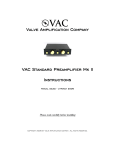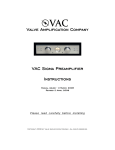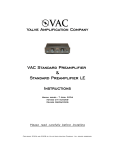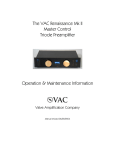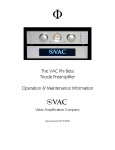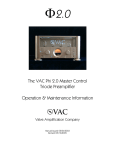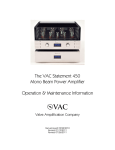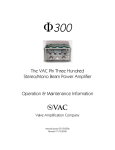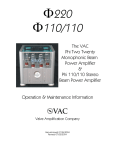Download VAC Standard Preamplifier Specifications
Transcript
The VAC Auricle Triode Preamplifier Operation & Maintenance Information Valve Amplification Company Manual issued 02/19/2004 CAUTION DO NOT REMOVE THE COVER UNLESS THE UNIT IS COMPLETELY UNPLUGGED - ALL CONNECTIONS MUST BE REMOVED - THEN WAIT 15 MINUTES BEFORE REMOVING THE COVER. DO NOT CONNECT OR OPERATE UNLESS THE COVER IS FULLY INSTALLED. LETHAL VOLTAGES ARE PRESENT WITHIN THE CHASSIS. DO NOT OPERATE THE UNIT IF IT IS WET. VACUUM TUBES BECOME HOT ENOUGH TO CAUSE SERIOUS BURNS. NEVER TOUCH A TUBE WHEN THE UNIT IS ON. IT MAY TAKE SEVERAL MINUTES FOR THE TUBES TO COOL DOWN AFTER THE UNIT IS SWITCHED OFF. BE CERTAIN TO INSTALL THIS UNIT IN A SECURE LOCATION FROM WHICH IT CAN NOT FALL OR TIP OVER. 1 VAC AURICLE PREAMPLIFIER Features: S S S S S S S S S All triode vacuum tube audio circuitry Passively equalized phono stage Triple shielded C-core power transformer Full tape loop Mono switch for minimizing noise from vintage records Remote control No loop feedback High input impedance, low output impedance Regulated filament supply CARE OF CHASSIS VAC chassis are aluminum for superior electromagnetic performance. The chassis is finished in a durable powder coat paint. Cleaning the unit with a damp cloth WHILE THE AMP IS SWITCHED OFF AND UNPLUGGED should suffice. Do not get cleaning solutions onto or into the tube sockets. 2 UNPACKING & ASSEMBLY The Auricle Preamplifier is shipped with the vacuum tubes installed. Should the need ever arise to replace the tubes, follow all of the safety directions contained in the beginning of this manual. INSTALLATION 1) Provide adequate ventilation. 2) Do not operate on carpet or any other surface that might block air flow. 3) The chassis will become warm in normal use. 4) Do not allow the chassis to touch any metal parts, such as the frame of an equipment rack. This might create a parallel ground path that could degrade the sound of your system. 5) All connections are via single ended RCA jacks. Connect line level inputs (CD, Tuner, Tape, etc.) to the appropriate RCA input jacks on the rear panel (L1, L2, L3, or Tape Play). Note: with the exception of Phono all inputs are "line level". The Tape Out jacks may be used to feed a signal to a tape or disc recorder. 6) Connect phono cables from a MM phono cartridge to the inputs labeled "Phono". Connect the ground wire(s) from the turntable(s) or phono cable(s) to the "Ground" terminal provided on the rear panel. 7) Connect the AC cable from the wall outlet to the preamplifier. Be sure to insert the connector properly and fully. 8) Operate only from the power supply voltage labeled on the rear panel (100, 120, 220, or 240 volts AC). For best performance, try to route the power cord away from signal cables. 9) Pay close attention to power quality, and be aware that different power cords can alter the sound. The backlit meter shows variation in power line voltage as reflected to the audio circuitry. 3 INPUTS (back panel) Three pairs of RCA jacks accommodate unbalanced line level sources. These are labeled "L1" through "L3". One pair of RCA jacks accommodate the monitor return from a tape deck. If you do not have a tape deck, these jacks can be used as an additional line level input. One phono input is provided for MM or ‘highouput’ MC cartridges. The ground lead from the turntable should be connected to the binding post located by these jacks. OUTPUTS (back panel) One pair of RCA jacks provide line level output to a tape recorder. The level of signal is not adjusted by the volume control. Two sets of RCA output jacks are provided as main outputs to power amplifiers; you may use either, or both for biamplification. 4 OPERATION Turn the "Volume" control fully counterclockwise. Mute is automatically engaged when switching on the unit. Allow the preamplifier to warm up for a minute before you un-mute the unit; failure to wait can cause a transient to be sent through your power amplifier that might cause damage to your loudspeakers. As with all high fidelity products, the sound characteristic of the VAC changes somewhat as it warms up. Best sound will be achieved after about 15 minutes of operation. Any time that the Auricle Preamplifier has not been used for a few weeks the sound may be different. This is also normal for high resolution audio equipment. Optimum sound should return after a few hours of operation, preferably with an audio signal. Note that although your VAC System has been run for 48 hours at the factory, it will continue to "break in" for approximately 150 hours. Also be aware that many components display the need for a new break in period after being transported in unheated cargo aircraft. 5 FRONT PANEL CONTROLS Although most of the front panel controls (Volume, Power, Mute) are self explanatory, VAC has outfitted this unit with several advanced features which bear further description: Mute: Toggles between the "Mute" and "Operate" condition. When muted, the indicator light is illuminated. Power: Turns the unit off and on. Mono: Causes the left & right channels to be electrically added. Generally, this will reduce background noise and distortion when playing monophonic analogue phonograph records. Selector: This switch selects between L1 through L3 and the PHONO input. Rotate counterclockwise to move down through the inputs, clockwise to move up through the inputs. Note: The MM input provides 44 dB of gain, suitable for use with MM (moving magnet) and many high-output MC (moving coil) cartridges. Tape: This switch selects between the signal coming from the main selector or the signal connected to the “TAPE IN” jacks. Volume: Controls the main output level for all inputs. Balance: Alters the signal levels between the left & right channels. This may be used to compensate for uneven room acoustics and speaker differences, or imbalance in source components. May also be used to compensate for slight variations in gain as tubes age. 6 REMOTE CONTROL The remote control allows for wireless adjustment of MUTE and VOLUME. The remote wand is powered by two "AAA" batteries. These should be of the alkaline type. You will need to install them in the wand before using the remote. Since batteries can leak, they should be removed from the wand if it is not going to be used for an extended period of time. To install or change batteries, first loosen the screw on the back of the remote, or slide off the battery door (depending upon the style of remote). Loosen the battery cover. Remove the battery cover. Insert two AAA batteries, observing the polarity diagram inside th battery compartment. Reassemble the remote control by following these steps in reverse. 7 REPLACEMENT OF LOW LEVEL TUBES We strongly recommend that you use only tubes specifically selected and tested by VAC for this application. Before replacing tubes, all power must be turned off and all cables disconnected. Allow 15 minutes for the tubes to cool down before removing the top cover. Install new tubes of the appropriate types firmly in their sockets, noting the location of holes in the socket and pins of the tubes, taking care to make sure that pin pattern corresponds to holes in tube socket. Replace the cover and secure it will all of the screws before connecting and/or operating the preamplifier. In the event that trouble is encountered, check all signal, speaker and power connections. If the problem persists, follow all safety precautions stated earlier in this section, and check that all tubes are correctly seated in their sockets. If possible, try another tube. If the problem persists, please consult your VAC dealer or contact the factory directly. Tubes are like the tires on a car; they will eventually need replacement. Murphy's Law states that a tube will probably fail right at the start of a long holiday weekend. Therefore, many audiophiles keep a spare tube of each type on hand, just in case! VAC can test tubes for concerned customers. V1 = 12AX7 low noise* V2 = 12AX7 low noise* V3 = 12AX7 V4 = 12AU7 V5 = 12AX7 V6 = 12AX7 V5 V6 V4 * low noise not necessarily required, but helpful with low output phono cartridges 8 V1 V2 V3 TIPS & ADVICE SECTION A Word About Tubes in General It is true that each brand of tube sounds different in a particular high resolution circuit. This is because no two manufacturers make a tube type in quite the same way, and the central tendencies of the performance parameters will differ slightly with each maker. To emphasize the point, examine the plate structure of any two 6SN7 from different manufacturers will probably find that they may not even the same shape and size. (Be careful here, as often a tube is made by a firm other than indicated on its label. In the heyday of tubes it was common to crossbrand between major labels, such as GE and RCA. Today many labels do not manufacture their tubes at all, including Gold Aero and RAM.) This sonic variability may at first seem a liability, but further thought will reveal that it is an advantage, just like the ability to adjust VTA on a tone arm. The owner of a tube amplifier can select those tubes which sound like the real thing in his/her specific system. Of course, if the manufacturer you prefer is rare you may want to purchase a few spare tubes for the future. How long should tubes last? It has long been known in professional circles (and probably now forgotten) that a tube such as the 12AX7 will display better performance characteristics after two years of continual operation than when it was new. In normal use it is not unusual for a low level tube to last 5 years or longer. Output tubes are another story, as they are continually providing significant amounts of current. Here the sound is your best guide. Certainly a tube should be replaced when its emission is significantly down or its transconductance is substantially out of specification. In normal use, output tubes will last at least 2 years and perhaps more than 5 years. In the event of unusual noise in one channel on all sources, the likely culprit is the 12AU7 tube. A loss of sound in one channel on all inputs probably is due to the V5 or V6 tube. Swap V5 (left) with V6 (right); if the problem changes channels then you have found the bad tube. A loss of sound or unusal noise in one channel on phono may be due to V1 or V2. Swap V1 (left) with V2 (right); you have found the bad tube if the problem changes channels. VAC can test tubes for concerned customers. 9 VAC AURICLE PREAMPLIFIER SPECIFICATIONS (typical) Type: Vacuum tube triode preamplifier with integral triple-shielded power transformer, remote control for volume & mute (manual only version available by special order), and passively equalized MM phono input. Line stage preamplifier: Gain: Maximum input signal: Main output: Tape output: 22 dB Infinite (attenuation precedes line stage) Inverting (you may reverse speaker connections if you wish to compensate, or set you d/a converter to phase reversal) Unity gain from selector, non-inverting Phono stage preamplifier: Gain: Residual noise: Overload: Frequency response: Notes: 40 dB (measured at tape output) less than 3 mV at output (S/N ratio approx. 69 dB) 117 mV @ 1 kHz = 8 volts RMS output 460 mV @ 10 kHz RIAA +/- .25 dB Does not invert absolute phase. Tube compliment: 5 x 12AX7 1 x 12AU7/6189A Warranty: Three years parts and labor, excluding tubes. 10 WARRANTY Your equipment is warranted for a period of thirty (30) days from the date of purchase. In addition, if the registration form is received by VAC along with a copy of your sales receipt from an authorized VAC dealer within this thirty days, a service contract will be extended to cover your equipment for three (3) years (tubes excepted). This warranty applies only to units sold in the United States of America through authorized VAC dealers. It covers factory service and standard return shipping. For warranty information outside of the U.S. contact the importer of VAC equipment for your country. Units sold outside of the U.S. should still be registered with VAC. It is responsibility of the dealer and customer to determine suitability of this unit for a given application. Your questions and comments are always welcome. Contact: Valve Amplification Company 1731 Northgate Boulevard Sarasota, FL 34234 Telephone (941) 359-2066 [email protected] Fax (941) 359-2057 _____________________________Detach and mail to the address above as soon as possible.____________________________ Auricle Preamplifier Registration Form Name ________________________________________________________________________ Address ________________________________________________________________________ ________________________________________________________________________ Telephone _______/_______-_____________ e-mail __________________________________ Dealer name ________________________________ City ________________________________ Salesperson ___________________ Purchase date ____________ Serial Number ________________ How did you first learn of VAC products? ____________________________________________________ What other brands/models did you consider? _________________________________________________ _____________________________________________________________________________________ What made you decide on the VAC? _______________________________________________________ _____________________________________________________________________________________ What else would you like us to know? _______________________________________________________ _____________________________________________________________________________________ _____________________________________________________________________________________ Optional: What magazines do you read regularly?________________________________________________________ What are your hobbies (besides filling in warranty cards)? _______________________________________ What are your favorite types of music? ______________________________________________________ _____________________________________________________________________________________ On what format? (CD, LP, DVD, SACD, MP3, etc.) ______________________________________________ 11












